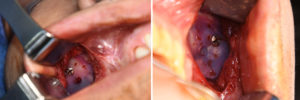Background: Cheek implants are a unique area in male facial augmentation because, to a large degree, that is not the gender that were made to primarily treat. Standard cheek implants are historically more successful in women because they create the so called ‘apple cheek’ effect, a midfacial look that is more appealing to more women than men. Often it is the high linear cheek look, somewhat similar to the lower linear look of the jawline, that is more aesthetically desired by men. In short standard cheek implants tend to feminine the male face in many cases.
While standard cheek implant styles and sizes may work for some men, it is not rare that the postoperative effect is not desired by the patient. This is compounded by the common risk of asymmetry with any cheek implant placement and the revision risk in male cheek implant surgery using standard predesigned styles occurs with some regularity. This is a common scenario for he request for custom cheek implants.
One major advantage of having standard cheek implants in place is that they provide a template to design an improved implant shape and size. When you have quantifiable implant dimensions combined with a visible external aesthetic effect, you have unique insights into how to create better implant designs.



Case Highlights:
1) Cheek implants that produce undesired aesthetic results are a common reason to use a secondary custom cheek implant replacement.
2) The first set of standard cheek implants serves as a blueprint in how to design better cheek implants.
3) While custom cheek implants are often bigger than what they replace, their recovery is usually better than the first time.
Dr. Barry Eppley
Indianapolis, Indiana




